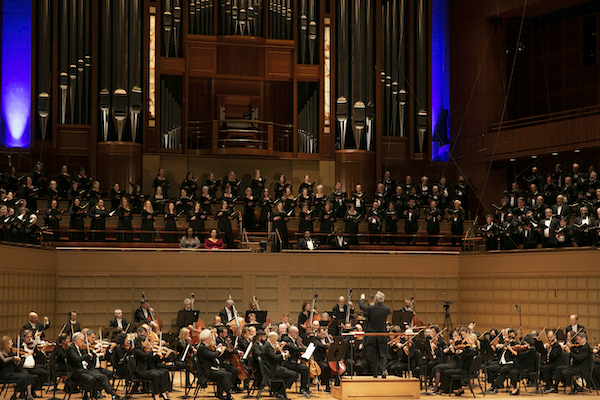Luisi, Dallas Symphony pair Beethoven’s Ninth with an Adolphe prelude

Dallas Symphony Orchestra music director Fabio Luisi brings a intriguingly curated program to Dallas this weekend. A co-commission of DSO and Bravo! Vail, Bruce Adolphe’s Diesen Kuss der ganzen Welt! was specifically designed to be programmed alongside Beethoven’s ubiquitous and immortal Symphony No. 9.
Luisi conducted the DSO in the work’s world premiere at the Bravo! Vail Music Festival last summer, and, in its Dallas premiere Thursday night, presented the same Beethoven-themed program to a packed house at the Meyerson Symphony Center.
Though performed with familiar brilliance and a splendor, experimentations in positioning with vocal and orchestral elements yielded hot-and-cold results in balance and blend.
Adolphe’s piece serves as the latest in his recent series of compositions inspired by specific Beethoven works, quoting Beethoven’s musical language in texture, melodic structuring, and instrumentation—not to mention the title. (“This Kiss to the Whole World” quotes from Friedrich Schiller’s text in the Ninth’s choral finale.)
Here, Adolphe’s work preambles Beethoven’s Ninth in both compositional material and thematic impetus, as Adolphe states, “…I chose this quote to be both the title and the message: that all humankind is together in this world, we are related, and we should celebrate our humanity with love and joy.”
Beethoven, a devout son of the Enlightenment and near-contemporary of Schiller, saw the ravages of the French Revolution and the ensuing absolutism of Napoleon’s regime spill across borders throughout Europe. Through the vehicle of this magnum opus, he reflects on war and destruction as violations against our human nature and, having borne witness to the fall of Napoleon and the restoration of order in Europe in 1814, envisions with optimism the eventual brotherhood of man.
Adolphe’s symphonic poem opened with tremolo strings, shimmering with the familiar brilliance and mystery of the No. 9’s opening fifths. With first and second violins split on either side of the stage and basses positioned back behind the horn section, Luisi managed an even, colorful balance that massaged low, menacing passages into a welcome blend. Peppery, playful percussion and bold brass proclamations highlighted the more spiky elements of Adolphe’s score, flashing amidst august counterpoint reminiscent of Beethoven’s Classical language. Presented sans intermission, the program allowed that the 10-minute work blend seamlessly into the marquee offering.
For the symphony, Luisi favored sonic heft, bracing dynamics, and speedy tempos, evidenced by one or two slights in orchestral cohesion. The first movement saw a lovely, dark opening that opened into thrilling fragmentations of the main theme. Likewise, drastic shifts in dynamics and the foreboding ostinato of the coda were executed deftly.
The iconic, thunderous octave strikes that open the second movement were followed by a hurried scherzo, where sections at times rhythmically disjoined. Winds, though, showed notably adroit precision in the movement’s playful Trio.
The songful Adagio movement was set in appropriately dark and even temperament against the boisterous movements surrounding it. Here, strings and winds provided a supple Romanticism and warmth.
The finale served as a welcome jolt back to frenzy with variations on the preceding themes and grand orchestral tuttis throughout. Lovely dynamic swells in cellos and basses ushered in the famous “Freude” theme before a militaristic outburst in orchestra beckoned in the choir and soloists—soprano Angel Blue, mezzo-soprano Taylor Raven, tenor Issachah Savage, and bass-baritone Soloman Howard.
Here, Luisi’s choices in positioning yielded less than desirable results. Setting the four soloists in the choral terrace with the choir had them fighting to push through the orchestra below with a loss of clarity in diction.
Nevertheless, Howard and Savage demonstrated potency and vigor in vocal delivery on their solo passages, and the quartet managed a brilliant, resonant ring during their ensemble moments. The DSO Chorus provided a solid foundation, a mostly solid foundation, apart fro the over-loud tenors, which affected overall tuning in big, forte moments.
With some adjustments in placement, this program might find itself not only powerful and exhilarating, but also acutely finessed.
The program will be repeated 7:30 p.m. Friday and Saturday and 3 p.m. Sunday. dallassymphony.org


